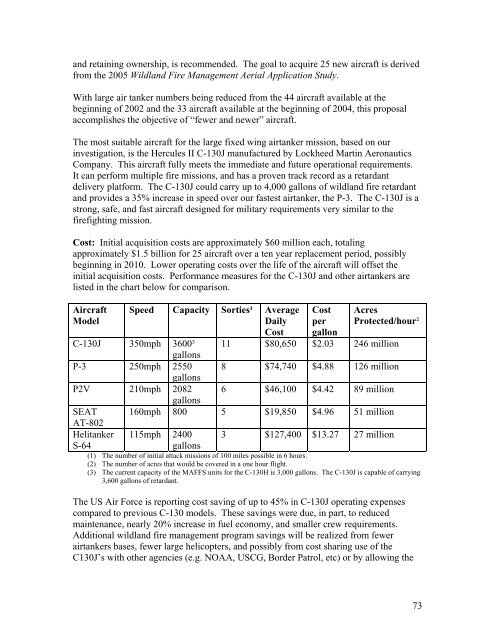Interagency Aviation Strategy - July 2008 - National Wildfire ...
Interagency Aviation Strategy - July 2008 - National Wildfire ...
Interagency Aviation Strategy - July 2008 - National Wildfire ...
Create successful ePaper yourself
Turn your PDF publications into a flip-book with our unique Google optimized e-Paper software.
and retaining ownership, is recommended. The goal to acquire 25 new aircraft is derived<br />
from the 2005 Wildland Fire Management Aerial Application Study.<br />
With large air tanker numbers being reduced from the 44 aircraft available at the<br />
beginning of 2002 and the 33 aircraft available at the beginning of 2004, this proposal<br />
accomplishes the objective of “fewer and newer” aircraft.<br />
The most suitable aircraft for the large fixed wing airtanker mission, based on our<br />
investigation, is the Hercules II C-130J manufactured by Lockheed Martin Aeronautics<br />
Company. This aircraft fully meets the immediate and future operational requirements.<br />
It can perform multiple fire missions, and has a proven track record as a retardant<br />
delivery platform. The C-130J could carry up to 4,000 gallons of wildland fire retardant<br />
and provides a 35% increase in speed over our fastest airtanker, the P-3. The C-130J is a<br />
strong, safe, and fast aircraft designed for military requirements very similar to the<br />
firefighting mission.<br />
Cost: Initial acquisition costs are approximately $60 million each, totaling<br />
approximately $1.5 billion for 25 aircraft over a ten year replacement period, possibly<br />
beginning in 2010. Lower operating costs over the life of the aircraft will offset the<br />
initial acquisition costs. Performance measures for the C-130J and other airtankers are<br />
listed in the chart below for comparison.<br />
Aircraft<br />
Model<br />
Speed Capacity Sorties¹ Average<br />
Daily<br />
Cost<br />
Cost<br />
per<br />
gallon<br />
Acres<br />
Protected/hour²<br />
C-130J 350mph 3600³ 11 $80,650 $2.03 246 million<br />
gallons<br />
P-3 250mph 2550 8 $74,740 $4.88 126 million<br />
gallons<br />
P2V 210mph 2082 6 $46,100 $4.42 89 million<br />
gallons<br />
SEAT 160mph 800 5 $19,850 $4.96 51 million<br />
AT-802<br />
Helitanker<br />
S-64<br />
115mph 2400<br />
gallons<br />
3 $127,400 $13.27 27 million<br />
(1) The number of initial attack missions of 100 miles possible in 6 hours.<br />
(2) The number of acres that would be covered in a one hour flight.<br />
(3) The current capacity of the MAFFS units for the C-130H is 3,000 gallons. The C-130J is capable of carrying<br />
3,600 gallons of retardant.<br />
The US Air Force is reporting cost saving of up to 45% in C-130J operating expenses<br />
compared to previous C-130 models. These savings were due, in part, to reduced<br />
maintenance, nearly 20% increase in fuel economy, and smaller crew requirements.<br />
Additional wildland fire management program savings will be realized from fewer<br />
airtankers bases, fewer large helicopters, and possibly from cost sharing use of the<br />
C130J’s with other agencies (e.g. NOAA, USCG, Border Patrol, etc) or by allowing the<br />
73
















